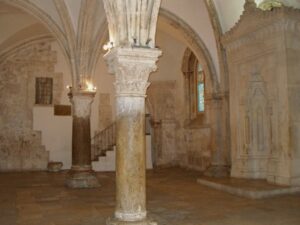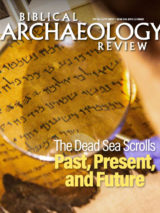The Hidden History of Jerusalem’s Upper Room
Reading medieval graffiti from the Holy City

Main hall of the Upper Room, located above the site suggested to be the location of the Last Supper. See The Holy Land, CC BY-SA 2.0, via Wikimedia Commons.
Just outside Zion Gate in Jerusalem’s Old City sits a small building considered by many Christians to be the location of Jesus’s Last Supper, and by Jews and Muslims to be the place of King David’s burial. Known today as the Upper Room or Cenacle, it has been a pilgrimage site for nearly a millennium. Now, an Israeli-Austrian archaeological team has identified more than 40 medieval inscriptions and graffiti carved into the walls of the Upper Room, several of which belong to important historical figures.

FREE ebook, Who Was Jesus? Exploring the History of Jesus’ Life. Examine fundamental questions about Jesus of Nazareth.
Leaving a Mark on the Upper Room
The Upper Room is one of the holiest sites in Jerusalem and has been a major feature of Christian pilgrimage since at least the fourth century, although the current building was constructed around the 12th century as part of a Latin monastery. Like many holy sites around Jerusalem, including the Holy Sepulchre, centuries of pilgrimage have left their mark on the building.

Digitally remastered black-and-white multispectral image of the “Teuffenbach” coat of arms from Styria. Directly below, the half-erased date 14.. can be seen. To the right are two further inscriptions: the monumental Armenian Christmas inscription and a Serbian inscription “Akakius”. Courtesy IAA, Shai Halevi.
Using cutting-edge multispectral and RTI photography, a joint project by the Israel Antiquities Authority and the Austrian Academy of Sciences has identified and studied more than 40 inscriptions and signs around the Cenacle that are barely visible to the naked eye. Among the carvings are several that can be directly linked to famous people or events. One such graffiti is the family crest of Tristram von Teuffenbach of Styria, who traveled to Jerusalem in 1436 with the then future emperor of the Holy Roman Empire, Frederick Habsburg.

Carved Coat of Arms with the inscription “Altbach”. This image is almost identical to the coat of arms of the modern city of the same name in southern Germany. It appears to have been left by an unknown pilgrim from the local knightly family. The cut drawings above the coat of arms show elements connected to the Last Supper: a goblet, a platter, and a round piece of bread. IAA, Shai Halevi.
One particularly intriguing inscription is written in Armenian and simply reads “Christmas 1300.” Despite its terse nature, the inscription can be tied to the Mongol conquest of Syria and the Levant in 1299. Among the troops fighting on behalf of the Mongols was the Armenian king Hethum II. Alongside the Armenians and other Christian groups from the Caucasus and the Levant, the Mongols successfully drove the Mamluk forces out of the region. Internal conflict, however, made the Mongols’ success short lived. The Armenian inscription is evidence that the troops of Hethum II were among the Mongol forces that reached Jerusalem.

General View of the Hall of the Last Supper on Mount Sion. At the opposite corner, Shai Halevi can be seen documenting an Arabic inscription. IAA, Joshua Faudem.
Another inscription is the signature of one Johannes Poloner from Regensburg, Germany, who recorded his pilgrimage to Jerusalem in 1421/22. Several other coats of arms and inscriptions were also found that record the presence of numerous other European pilgrims. However, the largest group of inscriptions belongs to Arabic-speaking Christians; one such Arabic inscription records the pilgrimage of a Christian woman from Aleppo.
Related reading in Bible History Daily
All-Access members, read more in the BAS Library
Archaeological Views: Mount Zion’s Upper Room and Tomb of David
Not a BAS Library or All-Access Member yet? Join today.
Must-Read Free eBooks
Want more Bible history?
Sign up to receive our email newsletter and never miss an update.
Unlock Unlimited Access to the Bible's Past
Become an All-Access Member to explore the Bible's rich history. Get Biblical Archaeology Review in print, full online access, and FREE online talks. Plus, enjoy special Travel/Study discounts. Don't miss out—begin your journey today!










